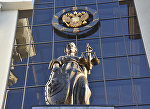MOSCOW, May 22 (RAPSI, Ingrid Burke) – A federal appeals court in Washington DC Tuesday affirmed that the US Central Intelligence Agency (CIA) acted properly in refusing to disclose 52 post-mortem images of al Qaeda Osama bin Laden as the images were properly classified as Top Secret.
The case was brought against the CIA and the US Department of Defense (DOD) by Judicial Watch, a non-partisan organization that aims to promote transparency, accountability, and integrity within the legal and political spheres, and which operates under the motto: “Because no one is above the law.”
Shortly after US President Barack Obama announced on May 1, 2011 that US military personnel had carried out a fatal attack against bin Laden in Pakistan and buried his body at sea, Judicial Watch filed requests with the CIA and DOD seeking the disclosure of photographic and/or video evidence in accordance with the US Freedom of Information Act (FOIA).
FOIA is a US federal law requiring government agencies to make certain types of information publicly accessible. Members of the public are able to file request forms with government departments and agencies, which in turn must either provide the information or prove that it cannot be released because it falls within the scope of one of nine valid exemptions to the law. The first such exemption applies to classified information. According to its text, government agencies are entitled to withhold certain records that are: “specifically authorized under criteria established by an Executive order to be kept secret in the interest of national defense or foreign policy and… are in fact properly classified pursuant to such Executive order.”
In response to the request, the DOD denied having possession of any images depicting bin Laden during or after the military operation. The CIA, on the other hand, acknowledged that it had in its possession 52 such images, but expressed its intent not to disclose any of them as they had been classified Top Secret.
As far as classified information is concerned, the Top Secret label is only extended to information that can be reasonably expected to cause “exceptionally grave” harm to national security.
Judicial Watch then filed the present lawsuit. The government parties then both moved for summary judgment, which was granted on the part of the CIA by the lower district court.
The CIA had introduced three declarations by high-ranking officials in support of its motion for summary judgment. All three had seen the images in question first hand, and each had his own reasons for believing that they should remain shielded from the public eye.
Director of the CIA’s National Clandestine Service (NCS) John Bennett asserted that the “quite graphic” and “gruesome” images could be used to spur retaliatory attacks and fuel anti-American propaganda. He added that if exposed, the images could threaten to expose certain US intelligence techniques.
Director of Operations, J3, at the Pentagon’s Joint Staff Lieutenant General Robert Neller argued that releasing the photos would threaten to incite violence and riots against the US and Coalition forces, placing innocent civilians at risk.
Commander of the US Special Operations Command Admiral William McRaven voiced concern that if released, the images would threaten to expose military personnel involved in the operation, thus exposing these individuals and their family to risk. He added that the exposure of certain methods depicted in the images could be expected to pose a threat to national security.
Judicial Watch argued that the CIA’s refusal to release the photos failed to satisfy the relevant classification criteria on either a substantive or procedural basis. To this point, a fourth CIA official - NCS Information Review Officer Elizabeth Culver – issued a declaration clarifying the protocol procedure underlying the classification of the relevant records.
Satisfied that any potential procedural defects had been remedied, the lower district court held that the CIA had properly withheld the images in compliance with FOIA’s classified information exemption.
In considering Judicial Watch’s appeal of the decision, the appellate court considered the relevant exemption, establishing that government agencies are generally granted significant deference in such cases. Citing relevant case law, the appellate court explained: “Ultimately, an agency’s justification for invoking a FOIA exemption is sufficient if it appears ‘logical’ or ‘plausible’,” in which case summary judgment is warranted.
The appeals court sided with the district court’s conclusion that the CIA declarations “give reason to believe that releasing images of American military personnel burying the founder and leader of al Qaeda could cause exceptionally grave harm,” in accordance with the relevant information classification requirement.
Judicial Watch had argued that the declarations only served to arouse concern that the release of these images may cause violence to occur overseas, and that the court – in the words of Tuesday’s decision – “should not succumb to this kind of blackmail.”
To this point, the court began by reminding the advocacy group that it had sued over the legitimacy of the use of a FOIA exemption, not over its constitutional rights.
It then added that they weren’t dealing with any ordinary type of photograph; rather they dealing in terms of the “consequences of releasing an extraordinary set of images, ones that depict American military personnel burying the founder and leader of al Qaeda.”
The court further pointed to its conclusion that the declarations at issue had dealt with specific, analogous examples.
Furthermore, in the court’s view the classification decision is aimed at preventing violence and homicide, rather than at saving face.


